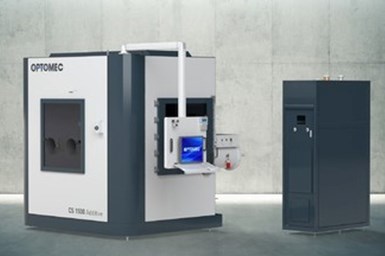Air Force Awards $1.5M Contract to Optomec for Additive Repairs
Company says additive repair solution for F35 large titanium blisk has potential to reduce costs by 80% and save tens of millions annually.
Share
Read Next

The Optomec additive manufacturing system is projected to reduce titanium blisk repair costs by 80%. Photo Credit: Optomec.
The U.S. Air Force has awarded Optomec a $1.5 million contract to develop a metal additive manufacturing (AM) system and process that enables the repair of oversized titanium components used in aircraft engines. The initial target is integrally bladed rotors (IBRs) or “blisks,” which are complex, single-piece compressor rotors made of lightweight titanium alloy that are routinely worn or damaged in normal use and can cost more than $500,000 each to replace with a newly made part.
It is said the implementation of an additive repair process for these parts is projected to result in greater than 80% in cost savings, which could save the Air Force tens of millions of dollars per year in maintenance costs. It would also shorten the supply chain for these critical components, which are used on aircraft such as the F22 Raptor and F35 Lightning II. Optomec says its solution will also benefit the broader commercial aviation market as engine OEMs continue to integrate larger, complex titanium components into their latest, fuel-efficient designs.
The contract deliverables include the commissioning of a large-format, 5-axis LENS/DED metal printer with a work envelope of 1500 × 1500 × 1000 mm (5 × 5 × 3 ft.), capable of handling IBR/Blisks up to 46″ in diameter. The system will be equipped with a gas purification system that maintains an oxygen- and moisture-free environment (<10 ppm), which is necessary to ensure excellent metallurgical and mechanical properties when depositing titanium, especially for flight-critical componentry. Additionally, the project will investigate the efficacy of various process monitoring techniques that track key variables as a validation and quality assurance measure.
The company says the project will employ those to develop and demonstrate viable repairs for large blisks, including restoration of both representative wear and foreign object damage (FOD) across critical areas of the individual blades. In a final step, Optomec will repair various sections of a large-scale blisk for evaluation in a spin pit test as an initial step on the path to qualification.
Optomec’s AM repair processes are currently used in high-volume production for other turbine engine parts worldwide, having repaired more than 10 million components over the last 20 years. This project will scale up Optomec’s solution for use on larger parts, with diameters greater than 1 m. In addition, Optomec will integrate its oxygen-free processing solution for titanium alloys, which it says is a key capability for defect-free, high-strength titanium processing.
“As OEMs lightweight and simplify their commercial and military aircraft engine designs, the industry is faced with larger, more complex titanium parts to maintain on the MRO side,” says Jamie Hanson, Optomec’s vice president of business development. “There’s no question that this project with the Air Force will benefit the broader aerospace market significantly over the next ten years.”
Related Content
-
7 Important Ideas on Postprocessing in AM
Additive manufacturing is defined by 3D printing, but it is more than this step. For almost every AM production part, steps after the 3D printing operation are essential to complete the part and realize its value. Here are several thoughts.
-
Is Every 3D Printed Replacement Part Inherently an Upgrade? AM Radio #32
Additive manufacturing is a powerful tool for replacement parts, but turning to AM offers opportunities beyond recreating what came before. In this episode of the AM Radio podcast, we discuss AM for repair, replacement and upgrades.
-
Aircraft Engine MRO: How Additive Manufacturing Plus Robotic Finishing Will Expand Capacity for Blade Repair
AM offers the chance to bring fast, automated processing to individualized, part-by-part restoration of turbomachinery. A cell developed by Acme Manufacturing and Optomec is able to automatically repair 85,000 unique aircraft engine blades per year.















